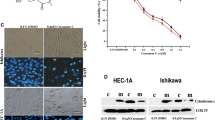Abstract
Sojucktang (SJT) has long been used for the treatment of endometrial diseases in Korea. However, the mechanisms responsible for the SJT-induced apoptosis in endometrial cancer cells remain unclear. In the present study, SJT was demonstrated to show cytotoxic effect and induce apoptotic cell death via mitochondrial regulation in KLE endometrial cancer cells. Linderae Radix, Glycyrrhizae Radix, Zedoariae Rhizoma, Trogopterorum Faeces and Agelicae Gigantis Radix were found to be the potent constituent herbs of SJT to significantly decrease the viability of KLE cells by a tetra zolium salt (XTT) assay. Apoptotic bodies were observed in SJT-treated KLE cells by 4′-6-diamidino-2-phenylindole (DAPI) and TdT-mediated-dUTP nick-end labeling (TUNEL) assay. SJT also increased sub-G1 DNA contents of the cell cycle undergoing apoptosis in a dose-dependent manner. Furthermore, it was observed that SJT activated caspase-3 and cleaved poly (ADP-ribose) polymerase (PARP), and decreased mitochondrial membrane potential in a dose-dependent manner. Taken together, this study shows that SJT exerts anti-tumor activity against KLE endometrial cancer cells via mitochondrial dependent apoptosis induction.
Similar content being viewed by others
References
Rose P G. Endometrial carcinoma. N Engl J Med, 1996, 335: 640–649
Southcott B M. Carcinoma of the endometrium. Drugs, 2001, 61: 1395–1405
Ingram S S, Rosenman J, Heath R, et al. The predictive value of progesterone receptor levels in endometrial cancer. Int J Radiat Oncol Biol Phys, 1989, 17: 21–27
Sorosky J I. Endometrial cancer. Obstet Gynecol, 2008, 111: 436–447
Stanojevic Z, Djordjevic B, Todorovska I, et al. Risk factors and adjuvant chemotherapy in the treatment of endometrial cancer. J Buon, 2008, 13: 23–30
Takai N, Ueda T, Nishida M, et al. Bufalin induces growth inhibition, cell cycle arrest and apoptosis in human endometrial and ovarian cancer cells. Int J Mol Med, 2008, 21: 637–643
Sha G H, Lin S Q. Genistein inhibits proliferation of human endometrial endothelial cell in vitro. Chin Med Sci J, 2008, 23: 49–53
Jost L M, Kirkwood J M, Whiteside T L. Improved short- and long-term XTT-based colorimetric cellular cytotoxicity assay for melanoma and other tumor cells. J Immunol Methods, 1992, 147: 153–165
Wang Z B, Liu Y Q, Cui Y F. Pathways to caspase activation. Cell Biol Int, 2005, 29: 489–496
Kerr J F, Wyllie A H, Currie A R. Apoptosis: A basic biological phenomenon with wide-ranging implications in tissue kinetics. Br J Cancer, 1972, 26: 239–257
Wyllie A H, Kerr J F, Currie A R. Cell death: The significance of apoptosis. Int Rev Cytol, 1980, 68: 251–306
Jacobson M D, Burne J F, Raff M C. Mechanisms of programmed cell death and Bcl-2 protection. Biochem Soc Trans, 1994, 22: 600–602
Thornberry N A, Lazebnik Y. Caspases: Enemies within. Science, 1998, 281: 1312–1316
Philchenkov A. Caspases: Potential targets for regulating cell death. J Cell Mol Med, 2004, 8: 432–444
Konopleva M, Zhao S, Xie Z, et al. Apoptosis. Molecules and mechanisms. Adv Exp Med Biol, 1999, 457: 217–236
Dowdy S C, Jiang S, Zhou X C, et al. Histone deacetylase inhibitors and paclitaxel cause synergistic effects on apoptosis and microtubule stabilization in papillary serous endometrial cancer cells. Mol Cancer Ther, 2006, 5: 2767–2776
Dolcet X, Llobet D, Pallares J, et al. FLIP is frequently expressed in endometrial carcinoma and has a role in resistance to TRAIL-induced apoptosis. Lab Invest, 2005, 85: 885–894
Shimizu S, Narita M, Tsujimoto Y. Bcl-2 family proteins regulate the release of apoptogenic cytochrome c by the mitochondrial channel VDAC. Nature, 1999, 399: 483–487
Petit P X, Zamzami N, Vayssiere J L, et al. Implication of mitochondria in apoptosis. Mol Cell Biochem, 1997, 174: 185–188
Sullivan P G, Dragicevic N B, Deng J H, et al. Proteasome inhibition alters neural mitochondrial homeostasis and mitochondria turnover. J Biol Chem, 2004, 279: 20699–20707
Author information
Authors and Affiliations
Corresponding author
Additional information
Supported by the Korea Science and Engineering Foundation (Grant No. KOSEF) funded by the Korea government (MEST) (Grant No. R13-2007-019-00000-0)
About this article
Cite this article
Oh, YS., Kwon, HY., Jeong, SJ. et al. Sojucktang induces apoptosis via loss of mitochondrial membrane potential and caspase-3 activation in KLE human endometrial cancer cells. Chin. Sci. Bull. 54, 4387–4392 (2009). https://doi.org/10.1007/s11434-009-0656-7
Received:
Accepted:
Published:
Issue Date:
DOI: https://doi.org/10.1007/s11434-009-0656-7




